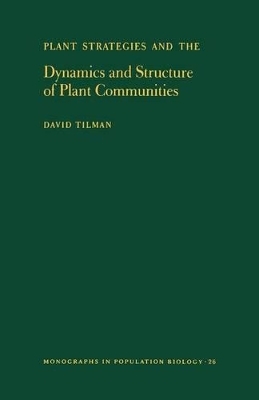
Plant Strategies and the Dynamics and Structure of Plant Communities
Seiten
1988
Princeton University Press (Verlag)
978-0-691-08489-3 (ISBN)
Princeton University Press (Verlag)
978-0-691-08489-3 (ISBN)
Providing a theory to predict the evolution of plant traits, this book explores the effects of these on plant community structure and dynamics. It also includes the constraint and tradeoff theory and suggests that most field experiments have been of too short a duration to allow unambiguous interpretation of their results.
Although ecologists have long considered morphology and life history to be important determinants of the distribution, abundance, and dynamics of plants in nature, this book contains the first theory to predict explicitly both the evolution of plant traits and the effects of these traits on plant community structure and dynamics. David Tilman focuses on the universal requirement of terrestrial plants for both below-ground and above-ground resources. The physical separation of these resources means that plants face an unavoidable tradeoff. To obtain a higher proportion of one resource, a plant must allocate more of its growth to the structures involved in its acquisition, and thus necessarily obtain a lower proportion of another resource. Professor Tilman presents a simple theory that includes this constraint and tradeoff, and uses the theory to explore the evolution of plant life histories and morphologies along productivity and disturbance gradients. The book shows that relative growth rate, which is predicted to be strongly influenced by a plant's proportional allocation to leaves, is a major determinant of the transient dynamics of competition.
These dynamics may explain the differences between successions on poor versus rich soils and suggest that most field experiments performed to date have been of too short a duration to allow unambiguous interpretation of their results.
Although ecologists have long considered morphology and life history to be important determinants of the distribution, abundance, and dynamics of plants in nature, this book contains the first theory to predict explicitly both the evolution of plant traits and the effects of these traits on plant community structure and dynamics. David Tilman focuses on the universal requirement of terrestrial plants for both below-ground and above-ground resources. The physical separation of these resources means that plants face an unavoidable tradeoff. To obtain a higher proportion of one resource, a plant must allocate more of its growth to the structures involved in its acquisition, and thus necessarily obtain a lower proportion of another resource. Professor Tilman presents a simple theory that includes this constraint and tradeoff, and uses the theory to explore the evolution of plant life histories and morphologies along productivity and disturbance gradients. The book shows that relative growth rate, which is predicted to be strongly influenced by a plant's proportional allocation to leaves, is a major determinant of the transient dynamics of competition.
These dynamics may explain the differences between successions on poor versus rich soils and suggest that most field experiments performed to date have been of too short a duration to allow unambiguous interpretation of their results.
| Erscheint lt. Verlag | 21.3.1988 |
|---|---|
| Reihe/Serie | Monographs in Population Biology |
| Verlagsort | New Jersey |
| Sprache | englisch |
| Maße | 140 x 216 mm |
| Gewicht | 454 g |
| Themenwelt | Naturwissenschaften ► Biologie ► Botanik |
| Naturwissenschaften ► Biologie ► Ökologie / Naturschutz | |
| ISBN-10 | 0-691-08489-0 / 0691084890 |
| ISBN-13 | 978-0-691-08489-3 / 9780691084893 |
| Zustand | Neuware |
| Haben Sie eine Frage zum Produkt? |
Mehr entdecken
aus dem Bereich
aus dem Bereich
Gefäßpflanzen: Grundband
Buch | Hardcover (2021)
Springer Spektrum (Verlag)
44,99 €
ein Baum erzählt seine erstaunliche Geschichte
Buch | Hardcover (2024)
Ludwig (Verlag)
23,00 €


